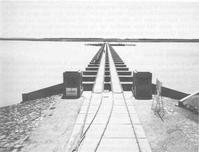


Chapter 3
I Background
II Early European Settlements
III Assessment Of Available Water Resources
IV Water Supplies For Goldmining Development
V Irrigation Development
i Channels, weirs and barrages
ii Measuring farm supplies - the Dethridge wheel
iii Early pumping schemes
iv Irrigation techniques
v Drainage of irrigated land
vi Recharge of aquifer
vii Soil-plant-water relationships
viii Carry-over storages and security of supply
VI Farm And Stock Water Supplies
VII Urban Water Supplies
VIII Wastewater Management And Treatment
IX Water Quality Management
X Limnological And Water Quality Research
XI New Techniques In Water Resource Planning And Management
XII Legislation
XIII Conclusion
XIV List Of Abbreviations
XV Acknowledgements
XVI Plantations-high Productivity Resources
References
Index
Search
Help
Contact us

Channels, weirs and barrages (continued)
In South Australia, a different type of weir was used in the Murray, as recommended by Colonel Johnson of the US Corps of Engineers in 1912. Each weir included a series of hinged trestles 6 m apart which, when the river was high, fell down flat on a concrete apron. When the river fell, the trestles were raised and carried an operating platform against which rested steel girders supporting hardwood panels. These weirs are still in use.The Goolwa Barrage, (Fig. 5) some 10 km from the Murray mouth, in South Australia, is another unique structure. Construction of this barrage restricted the ingress of seawater to the lower reaches of the river, converting Lakes Albert and Alexandrina into freshwater storages extending 150 km upstream to Blanchetown. These major structures have been in use for many years and are still giving good service. Conventional alternatives would have been much more costly because of the extremes of flow in the River Murray and the shape of its channel cross-section.

Distribution channels in irrigation areas reflected the technology of the late 19th century and early 20th century. Masonry and brick were the principal materials for large channel structures, with cast iron being used for gates and superstructure. For smaller structures, e.g., bridges over channels and channel regulators, the very strong and durable local red gum timber was used extensively. Many of these remained in service for over 50 years and some still exist.
Extensive use has been made of precast and prestressed channel structures since the early 1960s. Standard designs were developed for a wide range of bridge components, regulators and other structures. These units were usually fabricated at a central workshop for a large region, thus facilitating a high standard of quality control and economies of scale. Earthworks were carried out with steam shovels for deep cuttings and horse teams pulling ploughs and scrapers for the remainder. The horses' feet provided excellent compaction of channel banks, and the highly picturesque horse teams were used in Victoria and New South Wales up to 1939. They were inevitably replaced by mechanized equipment in the late 1940s as tractors, bulldozers, scrapers and draglines became generally available.
The profile of the early channels, with relatively flat side slopes, reflected the need to provide for ease of movement by horses rather than the most efficient hydraulic performance. This profile, however, also suited the type of channel regulator required for effective flow regulation in flat country, so that an acceptable compromise may well have been achieved by accident.
Organisations in Australian Science at Work - Goulburn Weir, Vic.
 |
Australian Academy of Technological Sciences and Engineering |  |
© 1988 Print Edition pages 158 - 161, Online Edition 2000
Published by Australian Science and Technology Heritage Centre, using the Web Academic Resource Publisher
http://www.austehc.unimelb.edu.au/tia/156.html